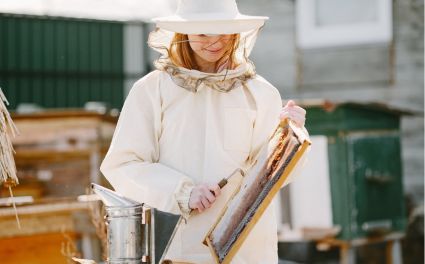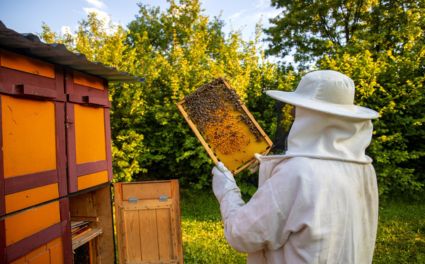Have you ever wondered how plants reproduce and create the fruits, seeds, and crops we depend on every day? The answer lies in the fascinating process of bee pollination. Bees are nature’s tireless workers — ensuring that our ecosystems thrive and our food supplies remain abundant. In this guide, we’ll explore how pollination happens, the vital role bees play, and how beekeepers contribute to supporting healthy bee populations with proper protective gear like beekeeping suits and beekeeping jackets.
🐝 The Bee Pollinator
Bees are among the world’s most efficient and important pollinators. Their fuzzy bodies, social habits, and constant movement between flowers make them perfect agents for transferring pollen.
Types of Bee Pollinators
Honey bees (Apis mellifera):
Honey bees are the most well-known pollinators, living in colonies with structured social systems. Worker bees forage for nectar and pollen, unintentionally transferring pollen from flower to flower as they collect food.
Bumblebees (Bombus spp.):
Bumblebees are robust and furry, able to pollinate even in cooler temperatures. They are known for “buzz pollination,” a vibration technique that helps release pollen from deep flower structures — essential for crops like tomatoes and blueberries.
Solitary bees:
Species such as mason bees and leafcutter bees work alone rather than in hives. Each female constructs her own nest, often in stems or wood cavities. Despite their solitary nature, they are highly efficient pollinators for gardens and native flora.

🌼 Behavioral Traits of Bee Pollinators
Foraging Behavior
Bees remember flower colors, shapes, and scents, which allows them to optimise their foraging routes. This consistent flower preference — called “floral constancy” — increases the chance that pollen reaches the same plant species, making pollination more effective.
Nectar and Pollen Collection
While searching for nectar, pollen grains stick to bees’ hairy bodies through static charge. As they fly to new flowers, some of this pollen rubs off onto the next flower’s stigma, enabling fertilisation. This process produces the seeds and fruits that sustain not only ecosystems but also our global food supply.
During hive work, beekeepers often wear beekeeping gloves and beekeeping veils to safely observe bee behaviour without disturbing their foraging or hive maintenance activities.
🌸 The Pollination Process
Pollination is nature’s delicate balancing act — a process that ensures the reproduction of countless flowering plants and agricultural crops.
1. Flower Visitation
Pollination begins when bees are attracted by vibrant colours and floral scents. As they land on a flower, they collect nectar for energy and pollen for protein, brushing against the flower’s reproductive organs in the process.
2. Pollen Transfer
When a bee’s body touches the stigma (the flower’s female part), pollen from another flower may stick, leading to fertilisation. Pollen grains adhere to bees’ fuzzy hairs, and even tiny movements from one bloom to another transfer the grains efficiently.
3. Cross-Pollination vs. Self-Pollination
-
Cross-pollination occurs between different plants of the same species, promoting genetic diversity and stronger, more resilient plant offspring.
-
Self-pollination happens within the same flower or plant and is useful when pollinators are scarce but limits diversity.
Bees are essential cross-pollinators, maintaining both wild ecosystems and large-scale agricultural productivity.
🌻 The Mutualistic Relationship Between Bees and Plants
The relationship between bees and flowering plants is mutualistic — both sides benefit from the exchange.
Benefits to Bees
-
Food Source: Bees rely on nectar for energy and pollen for protein to feed their larvae.
-
Habitat and Shelter: Flowers, trees, and plant stems often provide safe nesting sites for solitary bees.
Benefits to Plants
-
Pollination: Plants rely on bees to transfer pollen, enabling fertilisation and seed production.
-
Genetic Diversity: Bee pollination enhances genetic variation, helping plants adapt to environmental changes.
Over millions of years, bees and flowers have co-evolved — flowers evolved bright colours and sweet scents to attract bees, while bees developed physical traits and memory skills to collect nectar efficiently. This delicate partnership is essential for life on Earth.
🌿 Environmental Factors Affecting Bee Pollination
Bee pollination is vital but increasingly threatened by human and environmental pressures.
Habitat and Forage Availability
-
Habitat loss: Expanding urban areas and intensive agriculture reduce natural habitats and nesting options for bees.
-
Monoculture farming: Growing a single crop limits food variety for bees, affecting their nutrition and colony strength.
Pesticides and Environmental Stressors
-
Pesticide exposure: Chemicals like neonicotinoids harm bees’ nervous systems, impairing their navigation and communication.
-
Diseases and parasites: Varroa mites and fungal infections weaken colonies and can cause widespread die-offs.
-
Pollution: Air and water pollutants disrupt bees’ ability to locate flowers and forage safely.
Climate Change
Changes in temperature and rainfall patterns affect both bees and plants:
-
Flowers may bloom earlier or later, misaligning with bees’ active periods.
-
Bees may migrate to new regions, leaving some ecosystems without sufficient pollinators.
Supporting local beekeepers and maintaining hives responsibly — with proper beekeeping suits, beekeeping trousers, and beekeeping ankle protection — helps protect these essential insects while ensuring beekeeper safety.
👩🌾 The Role of Beekeepers in Supporting Pollination
Beekeepers play a vital part in conserving bee populations and promoting healthy pollination cycles. Through hive management, disease control, and safe handling, they maintain strong colonies that support surrounding ecosystems.
Wearing professional protective clothing such as beekeeping jackets, beekeeping gloves, and beekeeping veils keeps beekeepers protected while working closely with active hives. For younger enthusiasts, beekeeping kids suits offer the same level of safety and comfort, allowing children to learn about nature responsibly.
Reputable beekeeping brands such as OZ Armour design suits and accessories with features like multi-layer mesh, reinforced seams, and ventilated fabric — ensuring that beekeepers can manage hives safely without disturbing the bees’ natural behaviour.
🌎 Why Bee Pollination Matters
Bee pollination contributes to the growth of about one-third of the food we eat — from fruits and nuts to vegetables and seeds. Without bees, global agriculture would face massive challenges, leading to reduced biodiversity and food shortages.
Encouraging sustainable beekeeping practices, planting bee-friendly flowers, and reducing pesticide use can help sustain this critical ecological service.

🌼 Final Thoughts
The intricate process of bee pollination is one of nature’s most remarkable systems — a perfect example of balance and cooperation. Bees ensure the reproduction of flowering plants, while plants provide bees with nourishment and shelter. However, their survival depends on our awareness and action.
Supporting healthy bee populations through sustainable beekeeping, responsible hive management, and the use of quality protective wear like beekeeping suits and accessories helps maintain this harmony.
To continue learning about bees, pollination, and protective gear, visit the Beekeeping Blog to read more blogs about beekeeping and explore expert-written articles.
Brands like OZ Armour remain a trusted name in professional-grade beekeeping gear — helping beekeepers worldwide work safely and confidently while contributing to the protection of these extraordinary pollinators.



